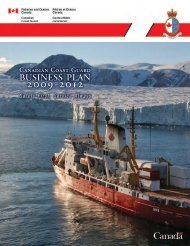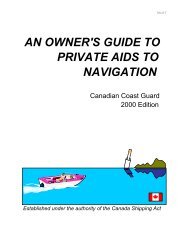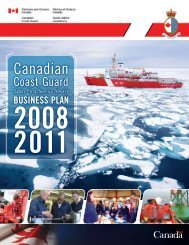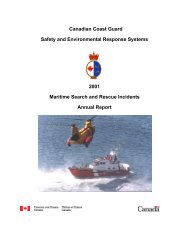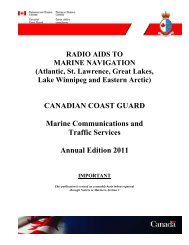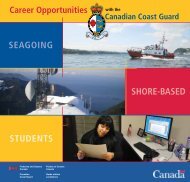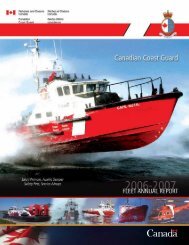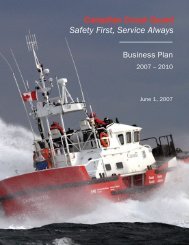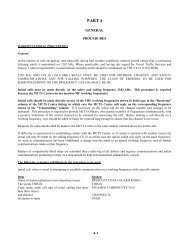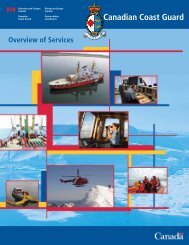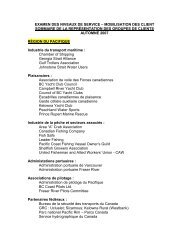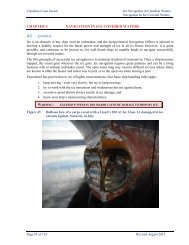RADIO AIDS TO MARINE NAVIGATION - Canadian Coast Guard
RADIO AIDS TO MARINE NAVIGATION - Canadian Coast Guard
RADIO AIDS TO MARINE NAVIGATION - Canadian Coast Guard
You also want an ePaper? Increase the reach of your titles
YUMPU automatically turns print PDFs into web optimized ePapers that Google loves.
COMMUNICATIONS<br />
Radiotelephone procedures used in communicating with an MCTS Centre are those specified by the International<br />
Telecommunications Union in the "Manual for Use by the Maritime Mobile and Maritime Mobile Satellite Services".<br />
A continuous listening watch shall be maintained on the appropriate VTS sector frequency on radio equipment located:<br />
• at any place on board the ship, where the ship is at anchor or moored to a buoy; and<br />
• in the vicinity of the ship’s conning position, where the ship is underway.<br />
A continuous listening watch may be suspended if an MCTS Officer directs the ship to communicate with coast stations<br />
and/or other ship stations on a different VHF radio frequency.<br />
All times given in local VTS zone reports should be in local time and in accordance with the 24-hour clock system.<br />
Navigation safety calls on designated VTS sector frequencies should be kept to the minimum consistent with the safety<br />
requirement of the situation.<br />
Communication Difficulties<br />
Where a ship, for any reason other than ship board radio equipment failure is unable to obtain the required traffic clearance<br />
or after receiving a traffic clearance, is unable to maintain direct communication with the appropriate MCTS Centre, the<br />
master may nevertheless proceed on his route, but shall take all reasonable measures to communicate with the appropriate<br />
MCTS Centre as soon as possible and obtain the specified clearance.<br />
Ship Board Radio Equipment Malfunction<br />
In the event of a ship board radio equipment failure where the ship is unable to obtain the required traffic clearance or after<br />
receiving a traffic clearance, is unable to maintain direct communication with the appropriate MCTS Centre, the vessel<br />
shall:<br />
(a) if it is in a port or anchorage where repairs can be made, remain in the port until the vessel is able to establish<br />
communications in accordance with the Vessel Traffic Services Zone Regulations; or<br />
(b) if it is not in a port or anchorage where repairs can be made, proceed to the nearest reasonably safe port or anchorage<br />
on its route and remain there until the vessel is able to establish communications in accordance with the Vessel Traffic<br />
Services Zone Regulations.<br />
English Language<br />
All communications with Tofino, Seattle, Prince Rupert, Comox, Vancouver or Victoria Traffic must be made in clear,<br />
unbroken English. At least one person capable of conducting two-way radio communications using the English language<br />
must be present on the bridge at all times within the CVTS reporting area. When language problems do arise,<br />
communications may be preceded by using message markers as found in the IMO Standard Marine Navigational<br />
Vocabulary (SMNV).<br />
ZONE DESCRIPTION<br />
Western Canada<br />
VTS Zones in Western Canada include all <strong>Canadian</strong> waters on the west coast of Canada as described in the VTS Zone<br />
Schedules of this Part and referred to in the Vessel Traffic Services Zone Regulations.<br />
3-2



